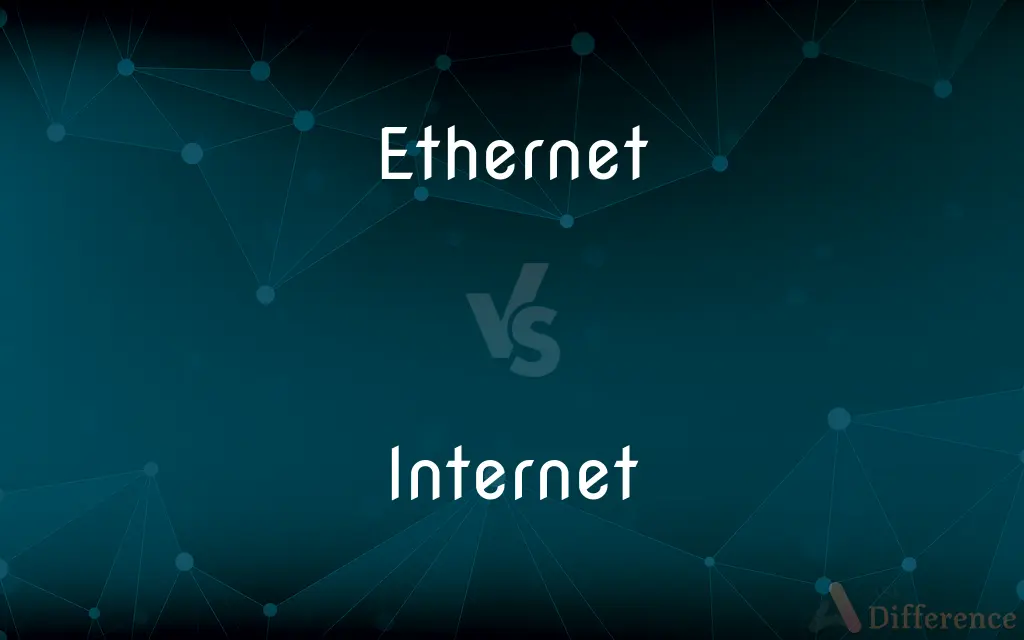Ethernet vs. Internet — What's the Difference?
Edited by Tayyaba Rehman — By Fiza Rafique — Updated on March 30, 2024
Ethernet is a technology for local network (LAN) wiring and communication, focusing on physical and data link layers, while the Internet is a global network of networks, enabling worldwide data exchange.

Difference Between Ethernet and Internet
Table of Contents
ADVERTISEMENT
Key Differences
Ethernet is a framework for connecting computers within a localized area, such as an office or home, using physical cables and switches to facilitate communication. On the other hand, the Internet spans the globe, connecting millions of networks through a vast array of technologies, including Ethernet, to share and access data universally.
While Ethernet operates primarily at the physical and data link layers of the OSI model, enabling devices within a LAN to communicate, the Internet functions across all layers, utilizing protocols like TCP/IP to ensure data is sent and received correctly and securely across diverse networks.
Ethernet setups are characterized by their use of hardware components like cables, switches, and routers to create a networked environment for data exchange within a limited area. Conversely, the Internet relies on a complex infrastructure of global data centers, undersea cables, and satellite links to connect disparate networks everywhere.
Speed and security within an Ethernet network can be tightly controlled since it is confined to a localized area and can be managed by network administrators. In contrast, the Internet's open nature means data security and speed are managed through encryption protocols and bandwidth regulations across different network segments.
Despite their differences, Ethernet and the Internet complement each other; Ethernet provides the foundation for creating local networks that can connect to the Internet, allowing devices to access global networks and services seamlessly.
ADVERTISEMENT
Comparison Chart
Scope
Local Area Network (LAN)
Global network of networks
Technology Layer
Physical and data link layers of the OSI model
Operates across all OSI model layers
Components
Cables, switches, routers
Data centers, undersea cables, satellite links
Connectivity
Connects devices within a localized area
Connects millions of networks worldwide
Primary Function
Facilitates communication within a LAN
Enables worldwide data exchange
Management
Managed by network administrators
Managed via protocols and global regulations
Security
Controlled and can be highly secure
Requires encryption for security
Compare with Definitions
Ethernet
A technology used for connecting devices in a local area network (LAN) through cables.
The office computers were interconnected using Ethernet for faster file sharing.
Internet
Enables access to global information, communication, and services.
People use the Internet for everything from research to online shopping.
Ethernet
Utilizes cables, switches, and routers for network setup.
Installing Ethernet requires physical cables to connect each device to the network.
Internet
Comprises a complex array of data centers, cables, and satellites.
The Internet's backbone includes undersea cables that connect continents.
Ethernet
Offers a high level of security within a localized network.
Ethernet networks can implement security measures like MAC address filtering.
Internet
Functions across all layers of the OSI model, ensuring end-to-end data transmission.
The Internet uses protocols like HTTP and TCP/IP for web browsing and data transfer.
Ethernet
Operates at the physical and data link layers of the OSI model.
Ethernet cables and switches are essential for creating a stable LAN.
Internet
Security is managed through encryption and various internet protocols.
Secure websites use HTTPS to encrypt data transmitted over the Internet.
Ethernet
Ideal for creating a secure, fast, and stable network environment in homes and offices.
Ethernet is preferred in office settings for its reliability and speed.
Internet
A global system of interconnected computer networks that use the Internet protocol suite (TCP/IP) to communicate.
The Internet allows for instant communication and information retrieval from anywhere in the world.
Ethernet
Ethernet () is a family of wired computer networking technologies commonly used in local area networks (LAN), metropolitan area networks (MAN) and wide area networks (WAN). It was commercially introduced in 1980 and first standardized in 1983 as IEEE 802.3.
Internet
The Internet (or internet) is the global system of interconnected computer networks that uses the Internet protocol suite (TCP/IP) to communicate between networks and devices. It is a network of networks that consists of private, public, academic, business, and government networks of local to global scope, linked by a broad array of electronic, wireless, and optical networking technologies.
Ethernet
Alternative case form of Ethernet
Internet
A publicly accessible system of networks that connects computers around the world via the TCP/IP protocol.
Ethernet
A type of networking technology for local area networks; coaxial cable carries radio frequency signals between computers at a rate of 10 megabits per second
Internet
Alternative case form of Internet
Internet
(uncountable) Internet access or connection; internet connectivity.
Do you have internet at your place? My internet is down and I want to check my email.
Hello everyone, this is your daily dose of internet.
Internet
(countable)
Internet
Any set of computer networks that communicate using the Internet Protocol; an intranet.
Internet
A fictitious unit of scoring awarded for making outstanding posts on the internet.
Internet
To use the Internet; specifically, to search for information using the Internet.
Having no idea what that means, I am internetting like mad.
Internet
To entwine or link (several things) together, so as to form a network; to interconnect, to network.
Internet
To connect (a computer, an electronic device, etc.) into a computer network (in particular, the Internet).
Internet
A large network{3} of numerous computers connected through a number of major nodes of high-speed computers having high-speed communications channels between the major nodes, and numerous minor nodes allowing electronic communication among millions of computers around the world; - usually referred to as the internet. It is the basis for the World-Wide Web.
Internet
A computer network consisting of a worldwide network of computer networks that use the TCP/IP network protocols to facilitate data transmission and exchange
Common Curiosities
What is Ethernet?
Ethernet is a technology for creating local area networks (LANs) through physical cables and switches.
Can Ethernet be used without the Internet?
Yes, Ethernet can create a network without Internet access, enabling local file sharing and communication.
What makes the Internet different from Ethernet?
The Internet is a global network for data exchange, while Ethernet is a local networking technology.
How does the Internet work?
The Internet works by connecting millions of networks globally, using protocols like TCP/IP for data transmission.
How is data transmitted over the Internet?
Data is transmitted using protocols like TCP/IP, ensuring it reaches its destination correctly.
How do global Internet connections work?
Global connections rely on undersea cables, satellites, and various routing protocols to link networks across continents.
Is Ethernet secure?
Ethernet networks can be highly secure, managed by network administrators with controlled access.
How do devices connect to the Internet?
Devices connect to the Internet through various technologies, including Ethernet, Wi-Fi, and mobile networks.
Why is Ethernet preferred in business environments?
Ethernet is preferred for its reliability, speed, and security in connecting devices within a business.
What role does Ethernet play in Internet connectivity?
Ethernet provides the infrastructure for local networks to connect to the Internet.
Can the Internet function without Ethernet?
While Ethernet is a common way to connect devices to the Internet, the Internet can also work with other technologies like Wi-Fi.
What are the main components of an Ethernet setup?
Key components include Ethernet cables, switches, and routers.
What measures can enhance Internet security?
Encryption, secure protocols, and careful network management can enhance Internet security.
What is the significance of the OSI model in understanding Ethernet and the Internet?
The OSI model helps differentiate the layers at which Ethernet and the Internet operate, highlighting their distinct functions.
Why might a home user choose Ethernet over Wi-Fi?
A home user might choose Ethernet for a more stable and faster connection, particularly for activities like gaming or streaming.
Share Your Discovery

Previous Comparison
Irony vs. Paradox
Next Comparison
Indemnity vs. IndemnificationAuthor Spotlight
Written by
Fiza RafiqueFiza Rafique is a skilled content writer at AskDifference.com, where she meticulously refines and enhances written pieces. Drawing from her vast editorial expertise, Fiza ensures clarity, accuracy, and precision in every article. Passionate about language, she continually seeks to elevate the quality of content for readers worldwide.
Edited by
Tayyaba RehmanTayyaba Rehman is a distinguished writer, currently serving as a primary contributor to askdifference.com. As a researcher in semantics and etymology, Tayyaba's passion for the complexity of languages and their distinctions has found a perfect home on the platform. Tayyaba delves into the intricacies of language, distinguishing between commonly confused words and phrases, thereby providing clarity for readers worldwide.
















































